The second and final part of a blog about flâneurs and research in the time of covid-19
As you can read in part one, this blog was inspired by daily walk – a stretching of locked-down legs – on which I saw a ghost sign for Diener’s Ice Works on a building in Prahran, Melbourne, and became curious about its history. Using only freely accessible online resources, the story I discovered was still too long for a single blog. After part one was published on 20 March 2020, I was contacted by two of Herbert Diener’s grandchildren, John Berry and Allen Feore: the best possible outcome! I have been thrilled to learn more about Herbert from them, and also to hear that my research has provided some new insights for his family.
My sincere thanks to John, Allen and their families for sharing the stories and photographs that illuminate the second and final part of this blog. The family history published by John Davies in 1991 has also provided much detail. It is interesting to see where my previous research ends and the ‘inside story’ begins, so I have tried to indicate that throughout.
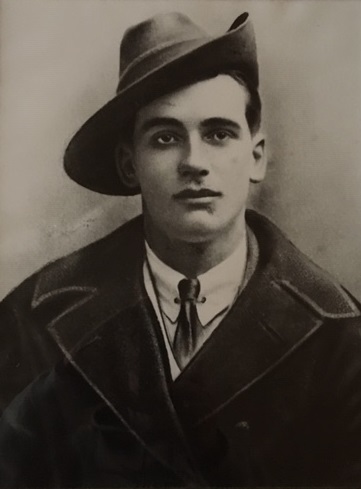
Before John and Allen contacted me, all I knew of Herbert’s movements during WWI and in its immediate aftermath came through his service record and newspaper articles. I had been puzzled by his re-enlistment – after being seriously injured in France in early 1918 – in Queensland later that same year. Allen Feore clarified this: Herbert’s second stint was as a technical sergeant working in recruitment, a way of continuing to serve despite his leg injury, which left him with a life-long limp and likely contributed to his early death.
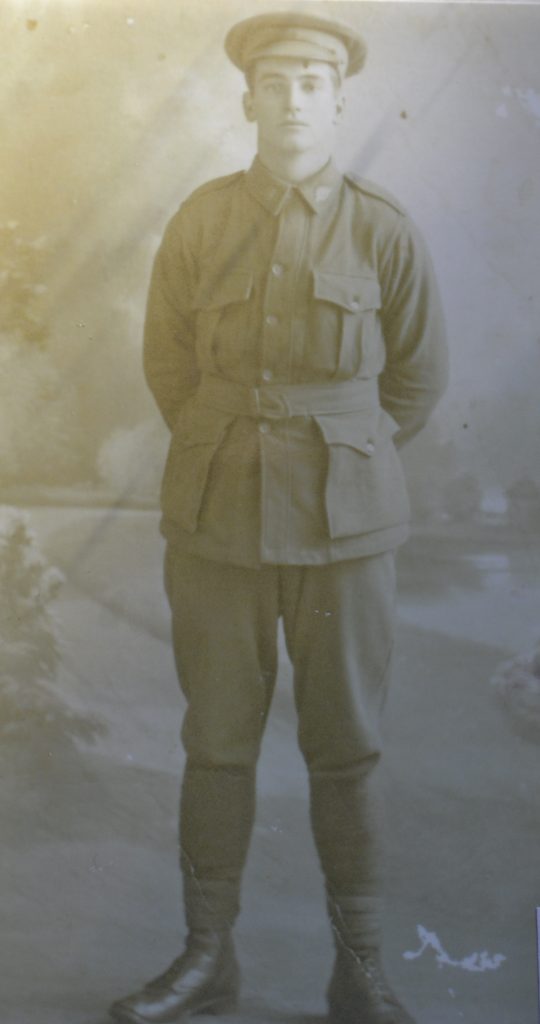
The sources told me that by in 1924, Herbert Diener was living in his parents’ hometown of Smithton, Tasmania, to where he requested (according to his AIF record) his Victory medal be posted. In 1926, still in Smithton, he sued an N.H. Moore for £5, 10 shillings and 3 pence, for “goods sold, plus interest.” Moore denied this charge, and as Herbert did not attend the hearing, the case was struck out.
Returning to Smithton after the war, Herbert married Keitha Morton (1905–1982). As Allen and John both told me, their family has long roots in Smithton. The Morton line began with British convicts transported to Smithton, while a family legend holds that the Dieners are descended from a German sailor who jumped ship in Fremantle, WA, in the mid-19th century. Together, Herbert and Keitha raised three daughters: Stephannie (mother of Allen and Raymond Feore), Peggy (mother of Jennifer and John Berry) and Nancy (mother of Jill, Carol and Michael Dufty), while Herbert worked hard to make a living as a farmer. This proved impossible, and so in 1926, Herbert and Keitha moved their family to Melbourne. One of the first things they had to do, grandson Allen told me, was choose a football team – a serious business for many Melburnians! They chose Richmond, an allegiance which continues among current generations of the Diener family.
In 1930, the Sands & McDougall Directory (p. 1261) for Melbourne reveals that Herbert was living at 37 Perth St, Prahran, Melbourne, not far from bustling Chapel St.
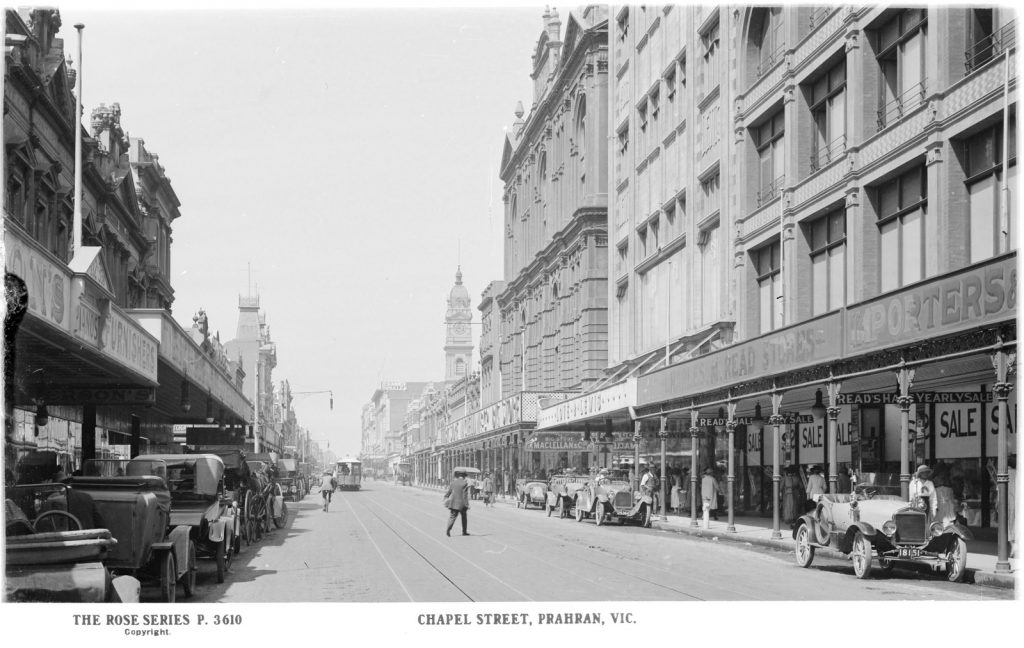
I interpreted the archival information as indicating that at some point between 1935 and 1940 (by which date he was listed in Sands & McDougall as “fuel merchant”, p. 1315), Herbert founded Diener’s Ice Works at 43 Greville St, Prahran. This corner address backed onto 41 Perth St, the site of one of 19 dairies operating in Prahran alone.

However, as John and Allen told me, in fact Herbert had first founded a wood yard, also on Greville St, next to Prahran railway station. The proximity of the two businesses (both of which were founded in the late 1920s – further research could determine exactly when) meant that on one memorable occasion, as Allen told me, Herbert stood at the Ice Works watching what he thought to be a delivery of wood up the road – it turned out to be an audacious daylight burglary! Thefts aside, the combination of the wood yard and the ice works provided a secure income for Herbert and his family, as these two key materials were needed by every household for heating, cooking and food storage.
Access to fresh milk, and the ability to keep food fresh, was vital for urban communities in the first half of the 20th century, as fewer and fewer people lived a self-sufficient lifestyle. In June 2017, GJM Heritage/Purcell produced an heritage citation document for Heritage Victoria about the dairy at 41 Perth St, which provides a wealth of information about the social history of dairies in inner Melbourne in this period. In the early part of the twentieth century, the dairy depot – distributing fresh milk to its local area – was an essential service. While people had fresh milk delivered daily, they still needed a way to keep food fresh at home, and the ‘ice man’ with his horse and cart was a ubiquitous figure on Victorian streets. James Harrison pioneered mechanised ice production in 1855, in Geelong, Victoria. In the 1930s when Diener started his business, ice boxes were still the most common form of domestic refrigeration.
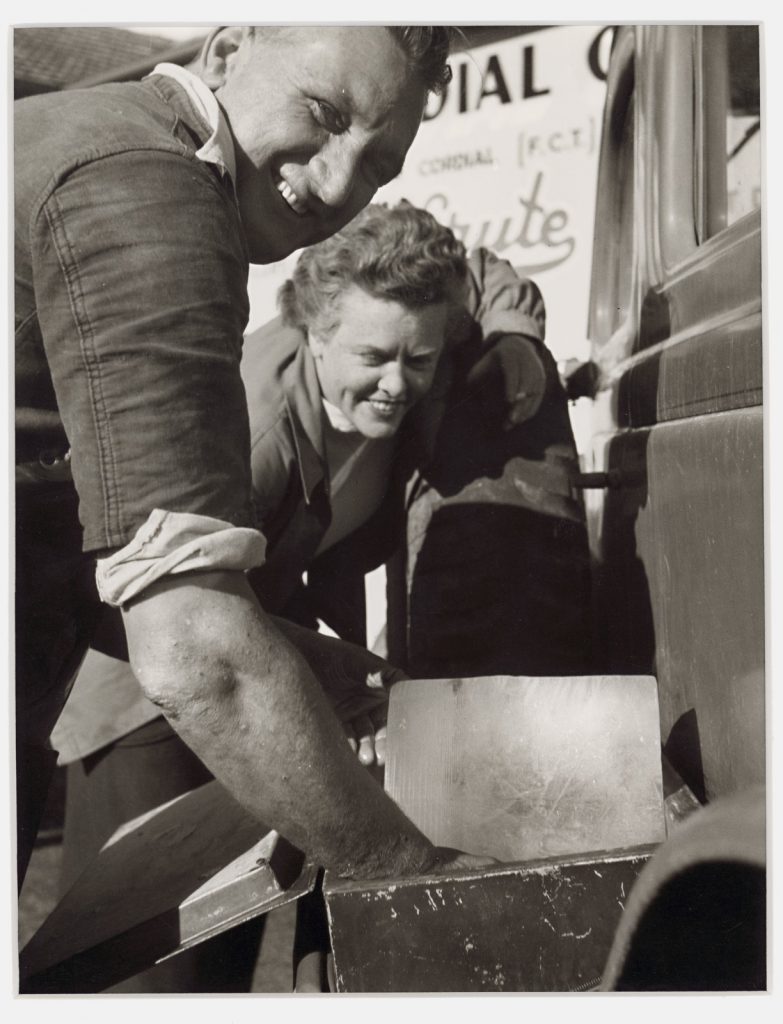
Blocks of ice like the one in this photograph would have collected by customers directly from the Ice Works or delivered to them at home, to be placed on a shelf in a domestic ice box. Charlotte Smith’s article for Museums Victoria about the history of domestic refrigeration quotes an 1838 description of this essential piece of domestic kit:
…a double box, the outside of mahogany or other wood, and the inside of sheet-zinc [or tin], the space between being three or four inches. By filling this space with finely powdered charcoal, well packed together, the box is rendered almost heat-proof, so that a lump of ice weighing five or six pounds may be kept twenty-four to thirty-six hours, even more, if the box is not opened too often, so as to admit the hot air from without. Of course while it is closed the air contained within it, being in contact with the ice, is reduced to nearly the same temperature; and meat is preserved perfectly sweet and good, the same as in winter. The interior of the refrigerator is provided with shelves for the reception of dishes, bottles, pitchers, etc.; and thus, by very simple contrivance, joints of meat are kept good for several days, wine is cooled, butter hardened, milk saved from ‘turning’, and a supply of ice kept on hand for the more direct use of the table.
In the Victorian Government Gazette of Wednesday 7 June 1944: “H. Diener of High-st Prahran” is registered as a fuel merchant. Diener’s Ice Works would have been a hive of industry in the 1930s and 1940s. Important for the wider community, the Ice Works was also a centre of activity for Herbert’s own family, being just over the back fence from his and Keitha’s home at 43 Greville St. Grandson Allen remembers exploring the Ice Works as a child, and the pungent smell of ammonia that wafted through its cool interior.
But by 1955, in the affluence of the post-war boom, 67% of households in Melbourne had a refrigerator, a change which had a big impact on businesses such as Diener’s Ice Works. Throughout November 1950, the auction of Diener’s Ice Works on 22 November was advertised in the Melbourne paper The Argus: “Fine modern brick factory, together with ice-making plant etc., as a going concern.”
Diener’s name is not listed in the 1950 Sands & McDougall Directory and I thought the business may have closed before that date. But as I learned from John Berry, the business did continue: his parents Ian and Peggy (Herbert’s daughter) took on the Ice Works, and moved their family into 43 Greville St, while Herbert and Keitha retired to the bayside suburb of Frankston. John and I pieced together that Herbert must have offered the business for sale before his parents volunteered to manage it.
John grew up at the Ice Works, helping with the home delivery service; it became the centre of another generation’s lives. He remembers that as domestic refrigeration became commonplace, the Ice Works moved into producing crushed ice, while still providing blocks for businesses like the nearby Chevron Hotel (corner Commercial and St Kilda Roads, Prahran), founded in 1934 as a luxury ‘country club’ and famed for its decorative ice sculpture.
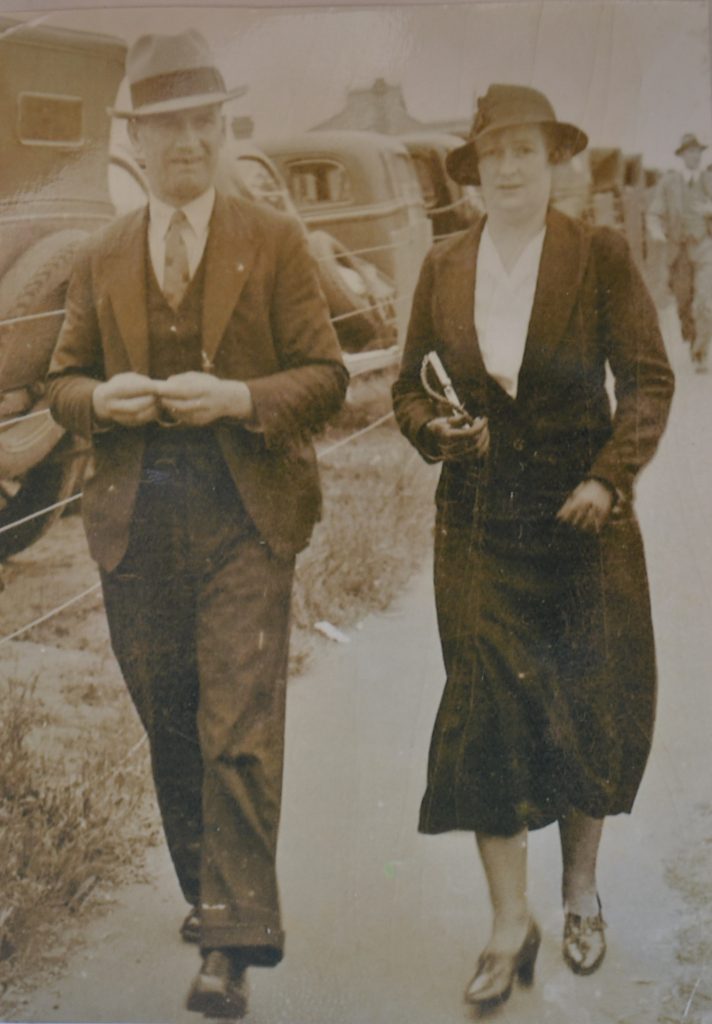
Photograph in the collection of Allen Feore, Herbert’s grandson.
Herbert had suffered the effects of his war injury all through his adult life, and it likely contributed to his death from a heart attack (caused by a blood clot) at the Heidelberg Repatriation Hospital, on 30 January 1957, aged just 58.[1] John’s family, the Berrys, continued to run the Ice Works until its closure as a business in 1967, by which time domestic refrigeration had well and truly taken hold.
All that remains of Diener’s Ice Works today is its façade, behind which sit two modern dwellings. But it remains a touchstone, an important site of memory, for the wider community and especially for Herbert’s family. When grandson John and his wife Lidya married, they had their reception in a local Diener family haunt, the College Lawn pub, and marked the occasion with a photo outside the Ice Works. Herbert’s war medals and ‘dog tag’ are treasured by his grandsons Allen and John, and a tradition of service has continued among them; the family is well represented by John and Paul and Glenn, his sons from his first marriage to Beverley Rand, at Anzac Day marches each year.
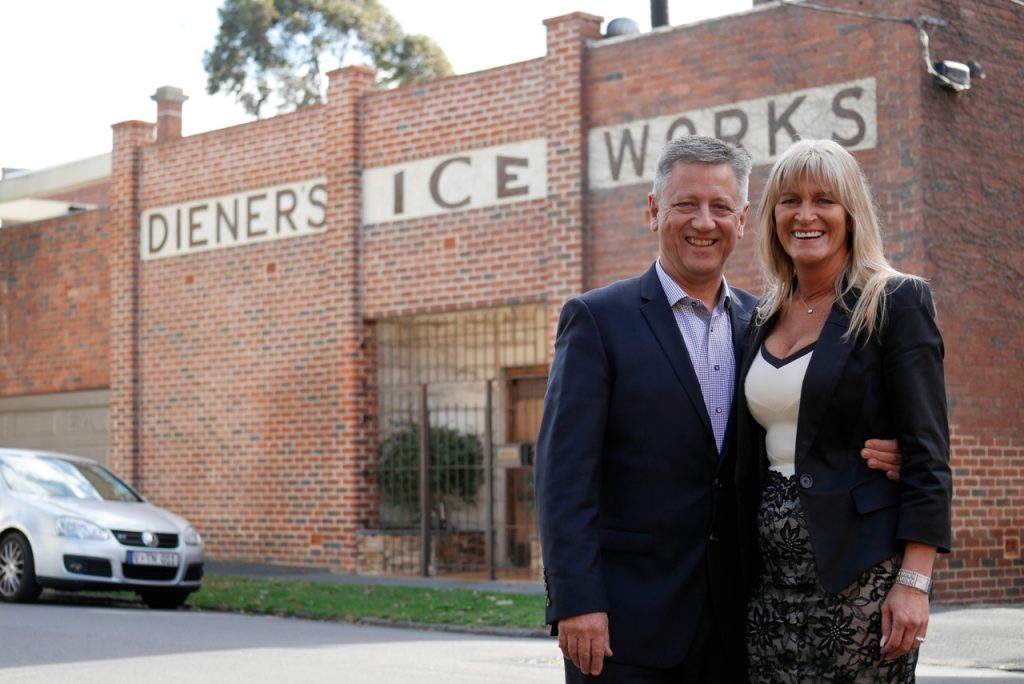
Photograph from the collection of John Berry, Herbert’s grandson
Herbert Diener lived through a period of intense global conflict, a major pandemic (the ‘Spanish flu’ of 1918-20), and rapid technological change, three phrases to which everyone living in 2020 might also relate. As we face our own experience of major social change, we are fortunate to do so in an era of unparalleled access to information and inspiration, and to communication. A stroll down a familiar street can become a journey through time – a vision of the individual threads that are woven together to form our tapestry.
[1] Herbert’s birth and death certificates could be purchased via Births, Deaths & Marriages Victoria: https://my.rio.bdm.vic.gov.au/efamily-history/5eb9e426d728981b2d2afb80/results?q=efamily. The freely accessible Ryerson Index provides the date and place of his death, 30 January 1957, http://ryersonindex.org/search.php.


Hi Anna,
Thanks for writing the Blogs it’s been great reliving our family’s past, job well done.
Thank you John! It’s been a great privilege to learn about your family’s history. Thanks for sharing your memories and photos so generously with us all. Best wishes, Anna
Fantastic read, so it turns out I have your Grandfather to thank for the Tiger legacy John. Very interesting story.
Great story Anna! I really enjoyed reading it and to see how one thing leads to another. I can’t believe how long ice boxes where used for! (I can see another story brewing about the invention of the refrigerator, from the guy in Geelong??? 🙂 )
Great to see some pics with the story as well. Thanks everyone!
Thanks Yvonne! Glad you enjoyed it.
Hi Anna, I loved reading your info on Deiners ice works …I remember living a few doors away from the ice works and used to play with Jennifer and John Berry….we loved going in to see how the ice was made and jump on the wood that was covering the water …
Thanks Suzanne, glad it brought back happy memories!
I was searching Google, when this article came up. It was not related to my Google search, but I sat here and really enjoyed reading both parts. Thank you for the work that you put into this article and thanks for posting it for us to read.